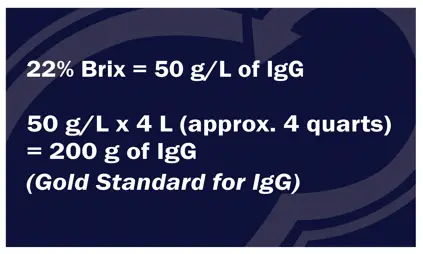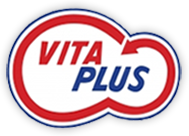
The great colostrum debate
 No one can agree if calves need more or less colostrum. If you’ve listened to colostrum chatter over the past few years, you’ve likely heard recommendations to feed more to aid in additional passive immune transfer. Recent field conversations are encouraging us to feed less. Why is there a discrepancy?
No one can agree if calves need more or less colostrum. If you’ve listened to colostrum chatter over the past few years, you’ve likely heard recommendations to feed more to aid in additional passive immune transfer. Recent field conversations are encouraging us to feed less. Why is there a discrepancy?
Start with the end goal in mind
Farms’ colostrum strategies may differ depending on the resources available to them, but the end goal is consistent across all colostrum programs: Elevate calf immunity through maximized immunoglobulin G (IgG) transfer.
A dairy calf is completely reliant on colostrum to build passive immunity, primarily through IgG antibodies. When a calf consumes its first meal, the IgG in colostrum is absorbed through the intestine. The gut has an “open-door policy” for large antibody absorption. Once the antibodies are absorbed, they are circulated throughout the body for pathogen surveillance.
However, this door does not remain open. Both time and colostrum ingestion lead to gut closure to prevent pathogens from entering the open door. This also closes the door for antibody absorption. After birth, it is generally accepted that the ability for calves to absorb IgG falls dramatically after 12 hours and is completely blocked after 24 hours.
Even if colostrum is fed immediately – when the door is open – only about 50% of the IgG in colostrum will be absorbed through the gut. This is described as “apparent efficiency of absorption.”
The discrepancies in the philosophies discussed comes down to how many IgGs are knocking at the gut door, and how long the door remains open.
The “baseline” philosophy
Following current textbook recommendations, the standard industry strategy is to offer a calf one feeding of 4 quarts of colostrum with a Brix score of at least 22%.
Where do these numbers come from?
- To mount a proper immune response, it is recommended that a calf have a serum IgG concentration of 25 grams per liter (g/L) or greater.
- Colostral IgG is not absorbed efficiently. A typical Holstein calf needs to ingest about 200 grams of IgG to achieve this serum goal.
- Colostrum quality at 22% Brix is equivalent to 50 g/L of IgG, so one would need to feed 4 liters, or roughly 4 quarts, to reach 200 g of IgG consumed and 25 g/L of IgG circulating.

The “feed more” philosophy
Following the textbook isn’t always feasible on-farm, so offering additional IgG can be a good insurance policy for calf health. After monitoring beef calves, researchers from the University of Guelph suggest that to truly build strong passive immunity, dairy calves could benefit from ingesting closer to 300 g to 400 g of IgG.
In other words, we want to get more IgG knocking at the gut door. Many calf specialists, myself included, recommended at least a second feeding of colostrum or transition milk, but there is still debate about the quality and volume to offer.
The “feed more” philosophy encourages getting the Brix percentage as high as possible and to offer a second 4-quart feeding within 12 hours. This is while the gut is still partially open, maximizing ingested and absorbed IgG.
The “feed less” philosophy
There comes a point of limited return with colostrum feeding. Let’s return to the concept of apparent efficiency of absorption. Both time and colostrum ingestion lead to gut closure and lower IgG absorption, but another important contributor is the IgG quantity fed.
As the amount of IgG ingested per feeding increases, absorption efficiency drops. IgG antibodies must bind to IgG receptors in the intestines before being absorbed, sort of like finding the “lock” for the opened gut door. Once all locks have bound to an IgG “key,” any remaining IgG keys cannot be bound and absorbed, reducing overall efficiency. The “feed less” philosophy argues that when we feed more colostrum per feeding, there are more IgGs knocking at the gut door, but they can’t get in.
The way to circumvent this issue while still providing more IgG is to increase total volume of colostrum, but in smaller volumes over more feedings.
A study by the same group at the University of Guelph found that offering the same volume of colostrum in two meals (one hour and 12 hours after birth) versus three meals (one, six and 12 hours after birth) lead to the equivalent of apparent efficiency of absorption.
This means that the gut does not fully close after multiple colostrum meals and multiple hours, so offering smaller, more frequent meals to the calf can still achieve excellent passive immune transfer.
I’ve also heard the argument from some veterinarians that offering few, high-volume feedings can be harmful to the calf. When fed two 4-quart colostrum meals in a short time frame, the calf ingests anywhere from 18% to 30% of its bodyweight in milk. That makes for a large curd in the stomach, prompting digestive upset and dehydration. By offering smaller meals and spacing out feedings, farmers can potentially promote calf comfort alongside immune status.
Take-home message
So, which philosophy is best for your operation? My first objective for any farm is to ensure that baseline colostrum goals are met to grow healthy calves, then expanding protocols beyond that. If your farm struggles with timely colostrum feeding, poor or unknown colostrum quality, the “feed more” philosophy is your best strategy for improved immunity. If you have the capability to harvest and feed high-quality colostrum for three to four meals, the “feed less” philosophy will promote calf comfort and immunity. For assistance in weighing your options, contact your Vita Plus calf specialist.
| Category: |
Calf and heifer nutrition Colostrum management Starting Strong - Calf Care |

